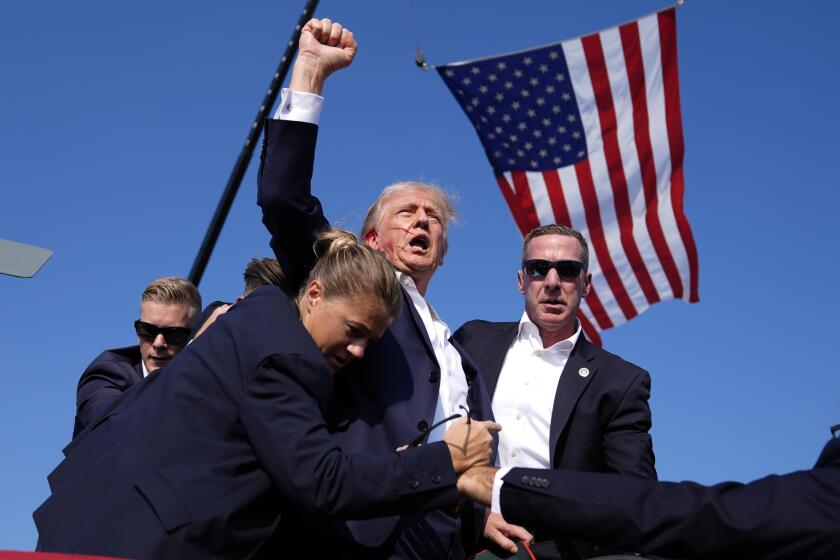Five takeaways from Trumpâs prime-time border security speech

President Trump speaks from the Oval Office in a prime-time address about border security Tuesday.
Reporting from Washington â President Trump gave his first prime-time Oval Office speech, focusing on what he declared to be a crisis on the countryâs southern border. The House and Senate Democratic leaders gave their responses. What did it all add up to? Here are five takeaways.
Neither side had new arguments to sway voters
Early Tuesday, Secretary of State Michael R. Pompeo said during an appearance in Jordan that Trumpâs speech âwill make a lot of news.â It didnât.
Trump stuck closely to talking points he has used for months, none of which have significantly boosted public support for his proposed border wall.
Democrats also stuck closely to the argument they have repeated since before the partial government shutdown began nearly three weeks ago â that theyâll negotiate with Trump after he signs a bill to fund government agencies, but not before.
As a result, the speech seems unlikely to significantly change public opinion. According to most polls, a majority of the public dislikes seeing the government shut down, and voters are more likely to blame Trump and the Republicans for the situation than Democrats. Thatâs why some Republican senators have been breaking ranks with Trump, while Democrats have remained publicly united.
The television networks gave the public a clear view of both sides
The decision by the broadcast television networks to air Trumpâs speech live in prime time drew sharp criticism.
In the end, however, airing both the speech and the Democratic response gave Americans a chance to hear both sidesâ arguments. That may not sway any votes, but it did leave the public better informed.
Trump tried to shift his rhetoric, but only part way
For days, administration officials have warned ominously of a terrorist threat at the border and have talked in terms of a ânational security crisis.â Those assertions have been repeatedly debunked, and administration spokespeople have been heavily criticized for making false claims.
Trump largely steered clear of those assertions. Instead, he began his speech by talking of a âhumanitarian crisis.â
That may reflect a recognition on the part of administration officials that their previous arguments have not fared well.
But Trumpâs language was at war with itself. Even as he tried to convey compassion for migrants, talking of the dangers they face on the trek north to the border, Trump also repeated his emphasis on cases in which immigrants in the country unlawfully have killed or injured U.S. citizens, including a 2015 case in which an Air Force veteran in California was raped and killed by a man in the country illegally.
Immigrant advocates say Trumpâs use of isolated criminal cases unfairly tars all immigrants as criminals. Such rhetoric has been a staple of his campaign since its earliest days, which has hardened Democratsâ attitudes against him.
The administration is trying to widen the debate beyond Trumpâs wall
The wall has consistently been unpopular with Americans. But when the issue is framed more broadly as âborder security,â pollsters find that Trumpâs positions fare better.
In his speech, Trump talked of the need to increase spending on a broad range of immigration-related items, including more immigration judges, an idea that he ridiculed last year, although his administration has, in fact, hired more of them.
In theory, widening the discussion could provide room for a compromise between Trump and Congress. So far, however, Trump has refused to budge from his demand for $5.7 billion for a border barrier, which Democrats have said they wonât vote for.
Negotiations have been largely at a standstill, in part because both parties have experience with Trump seeming to agree to a compromise, then backing away. Neither Democrats nor Republicans want to commit to a deal unless theyâre sure this time that Trump will stick to it.
A declaration of a national emergency remains one possible outcome
Trump avoided any mention of declaring a national emergency in Tuesdayâs speech, but it remains under active discussion.
If Trump declared an emergency at the border, he could claim authority to use military construction funds to pay for a border barrier, a possibility his advisors have discussed. He would face legal challenges, and might lose ultimately, but in the meantime, he could sign the bills to reopen government agencies without going back on his promise to build a wall.
At least some Republicans on Capitol Hill believe that scenario, which would shift the fight over the wall out of Congress and into the courts, may be their best way out of the current standoff.
Times staff writers Eli Stokols and Molly OâToole contributed to this report.
Get the latest news from the nationâs capital on Essential Washington >> Âť
Pictures in the News | Wednesday Jan. 9, 2019 Âť
For more on Politics and Policy, follow me @DavidLauter
More to Read
Get the L.A. Times Politics newsletter
Deeply reported insights into legislation, politics and policy from Sacramento, Washington and beyond. In your inbox three times per week.
You may occasionally receive promotional content from the Los Angeles Times.











